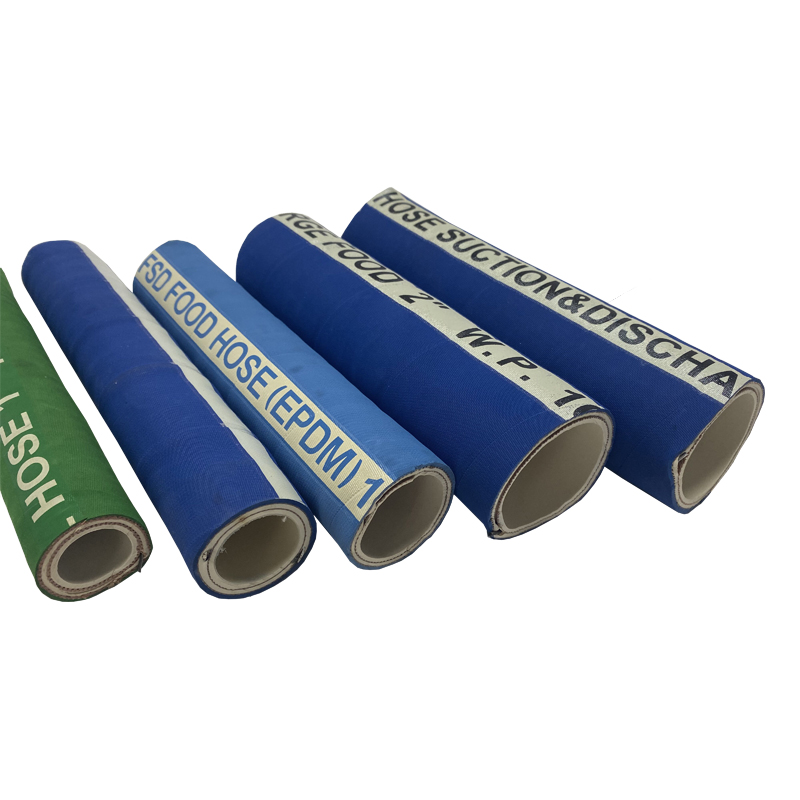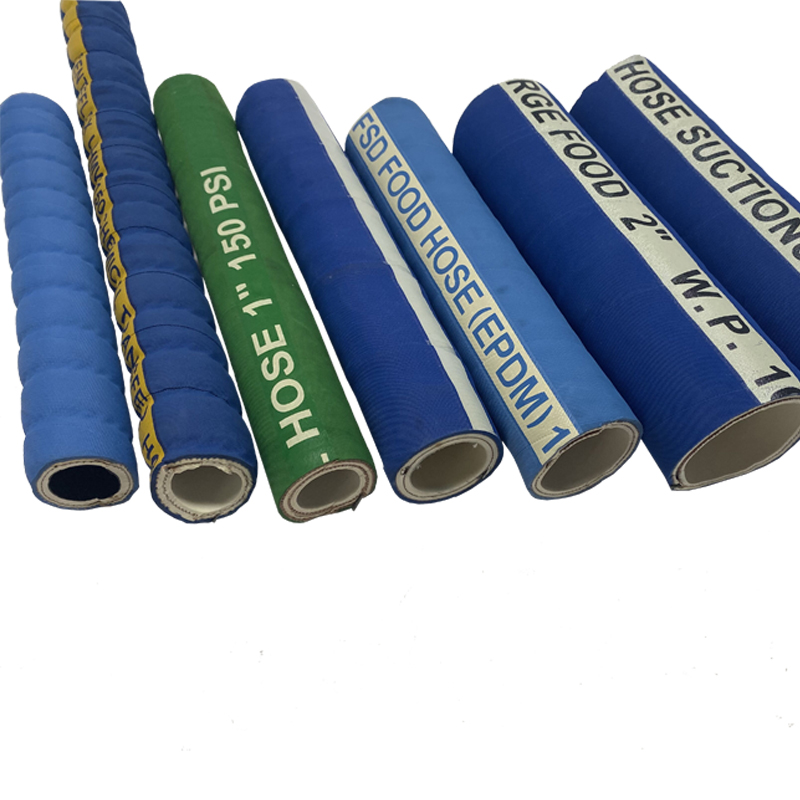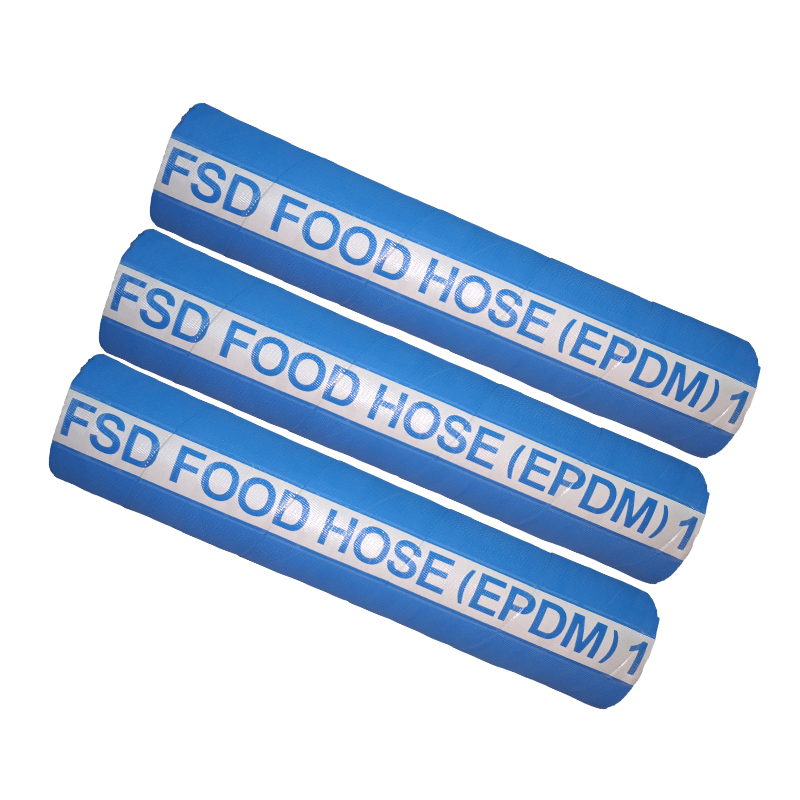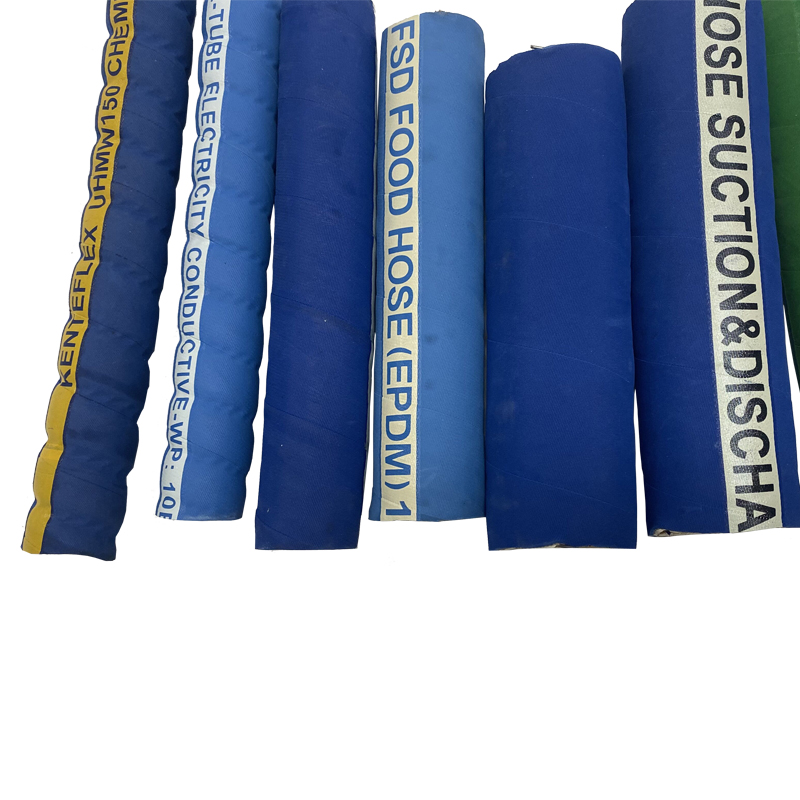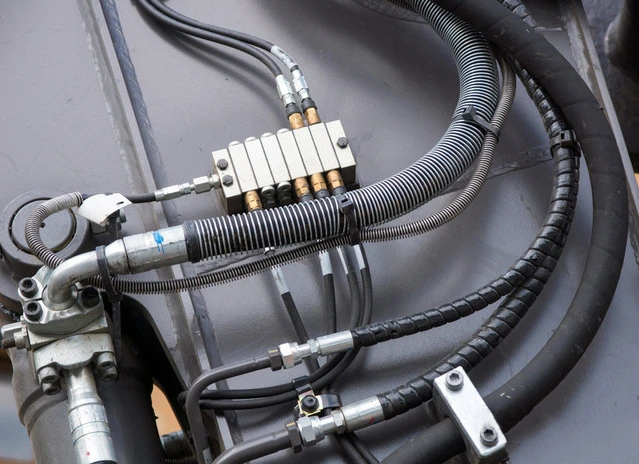
I tubi in gomma Food Grade con FDA sono comunemente usati in molti settori diversi. Sono ampiamente usati per scaricare e aspirare solidi, liquidi e altri prodotti alimentari. I tubi in gomma Food Grade sono realizzati con vari composti di gomma e sono rinforzati con fili sintetici ad alta resistenza o una combinazione di entrambi.
I tubi in gomma per uso alimentare sono realizzati per soddisfare le condizioni difficili degli impianti di lavorazione alimentare. Possono resistere a una manipolazione brusca e a situazioni di alte temperature. I tubi flessibili per uso alimentare di buona qualità possono sostenere un'alimentazione ad alta pressione.
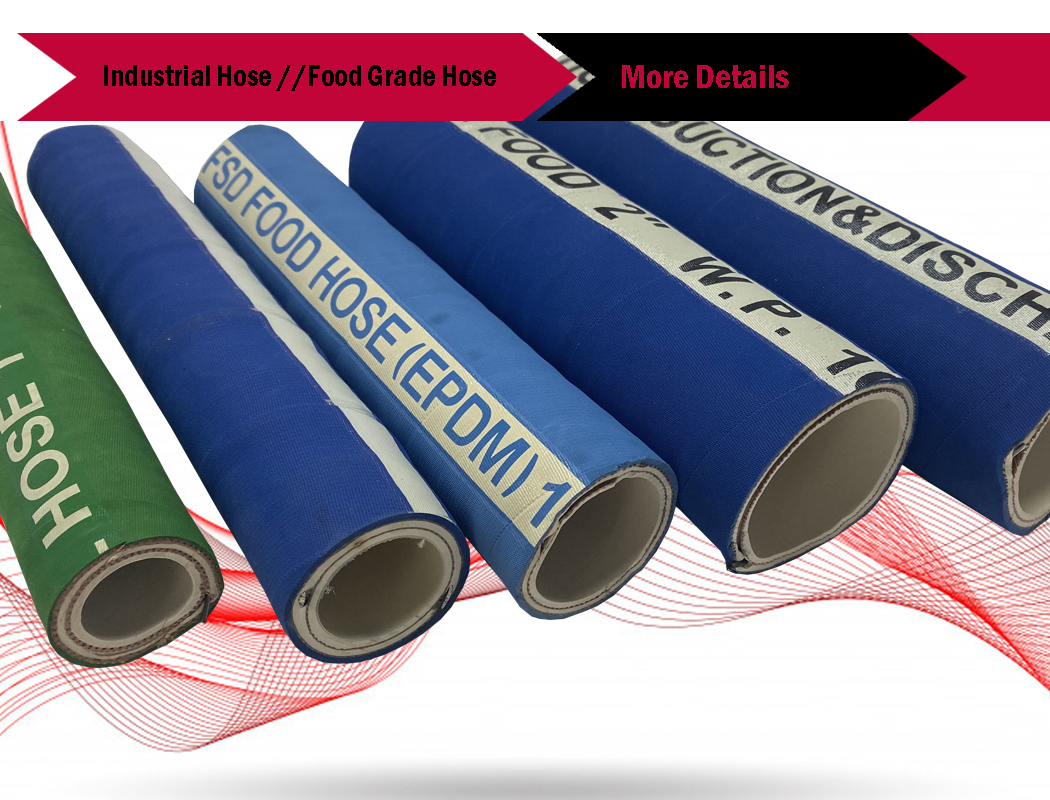
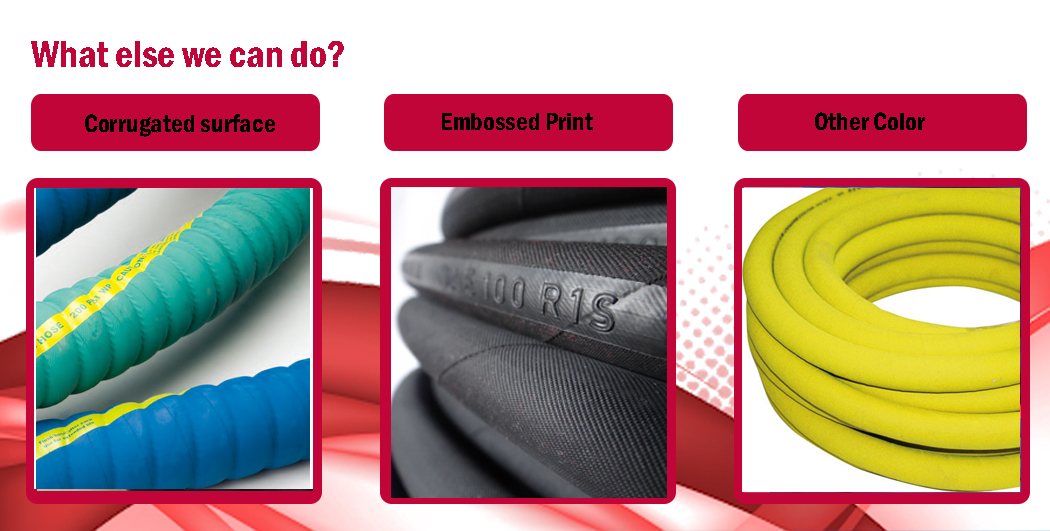
| Numero parte | ID | DI | Pressione di lavoro | Pressione di scoppio | Strato | |||
| pollice | mm | mm | Sbarra | psi | Sbarra | psi | piegare | |
| FD300-04 | 1/4" | 6.4 | 14.0 | 20 | 300 | 60 | 900 | 1 |
| FD300-05 | 5/16" | 7.9 | 16.0 | 20 | 300 | 60 | 900 | 1 |
| FD300-06 | 3/8" | 10.5 | 18.0 | 20 | 300 | 60 | 900 | 1 |
| FD300-08 | 1/2" | 12.7 | 22.0 | 20 | 300 | 60 | 900 | 1 |
| FD300-10 | 5/8" | 15.9 | 26.0 | 20 | 300 | 60 | 900 | 1 |
| Modello FD300-12 | 3/4" | 19.1 | 29.0 | 20 | 300 | 60 | 900 | 1 |
| FD300-16 | 1" | 25.4 | 37.0 | 20 | 300 | 60 | 900 | 2 |
| FD300-20 | 1-1/4" | 31.8 | 45.8 | 20 | 300 | 60 | 900 | 4 |
| Modello FD300-24 | 1-1/2" | 38.2 | 52.6 | 20 | 300 | 60 | 900 | 4 |
| Modello FD300-32 | 2" | 50.8 | 65.6 | 20 | 300 | 60 | 900 | 4 |
| FD300-40 | 2-1/2" | 64.0 | 80.2 | 20 | 300 | 60 | 900 | 6 |
| FD300-48 | 3" | 76.0 | 93.4 | 20 | 300 | 60 | 900 | 6 |
| FD300-64 | 4" | 102.0 | 120.6 | 20 | 300 | 60 | 900 | 6 |
| FD300-80 | 6" | 152.0 | 170.6 | 20 | 300 | 60 | 900 | 6 |
Tubo per uso alimentare
Copertura resistente alle intemperie e all'abrasione
Gestione di un'ampia varietà di prodotti alimentari
Sono disponibili sia coperture lisce che ondulate
La nostra fabbrica non utilizza materiali riciclati, prima della produzione effettueremo test di pressione e di resistenza alla trazione, dopodiché monitoreremo la vulcanizzazione.
1. Trasferimento di processo, stazioni di lavaggio, lavorazione di alimenti alla rinfusa.
2. Il tubo flessibile per uso alimentare è adatto per l'aspirazione e lo scarico di vino, birra e altri liquidi alimentari come latte, sidro, succhi di frutta e alcol fino al 96%, specificamente progettato per il trasferimento di serbatoi nella produzione di bevande, aziende vinicole, birrifici e distillerie.

Perché sceglierci?
1.15 anni di esperienza e produttore certificato ISO 2015
2. I test di laboratorio ci forniscono materie prime di qualità TOP
3. La carta di responsabilità supervisiona ogni fase della produzione
4. Rigoroso controllo di qualità dopo la produzione
5. Vendite veloci, amichevoli, competenti e professionisti delle vendite con servizio di orario lavorativo esteso
6. Garanzia e assistenza post-vendita
7. È disponibile il servizio di assistenza OEM.
We strive to be the best fluid and power convey company in the world to make our products not only outperform industry standards, but also exceed our customers’ demanding expectations.
SINOPULSE benvenuti a tutti i nuovi clienti e clienti contattateci per future interazioni di piccole imprese e reciproco successo. I prodotti saranno forniti in tutto il mondo, come Italia, Germania, Regno Unito, Spagna, USA, Canada, Brasile, Argentina, Panama, Perù, Cile, Vietnam, Indonesia, Australia... siamo fiduciosi che avremo una prospettiva vivace e saremo distribuiti in tutto il mondo nel prossimo futuro.
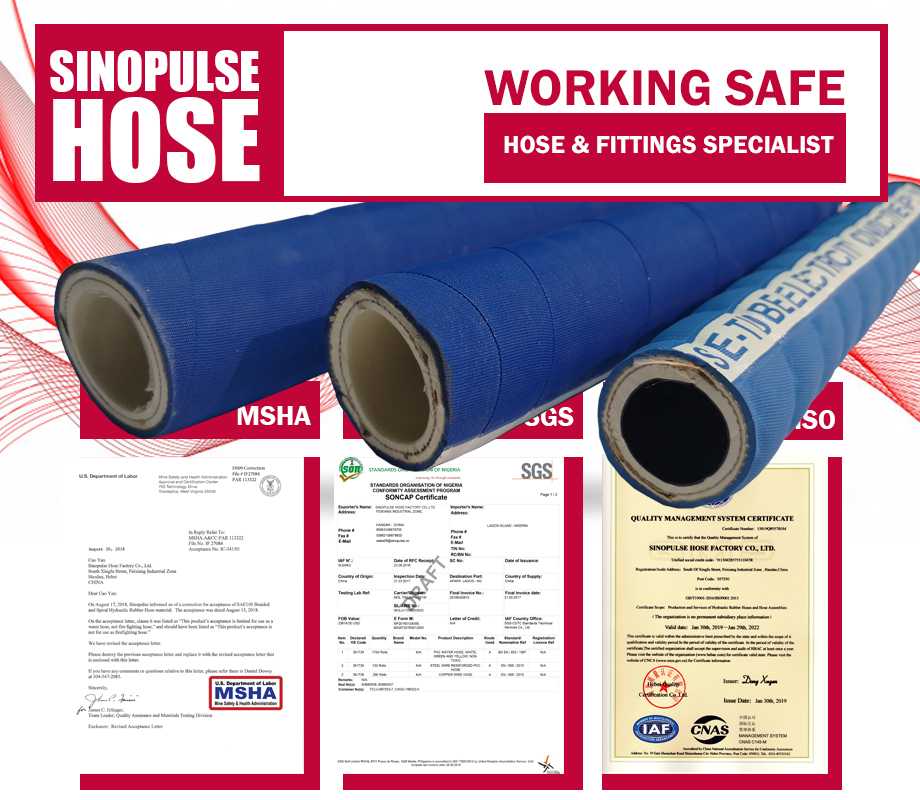
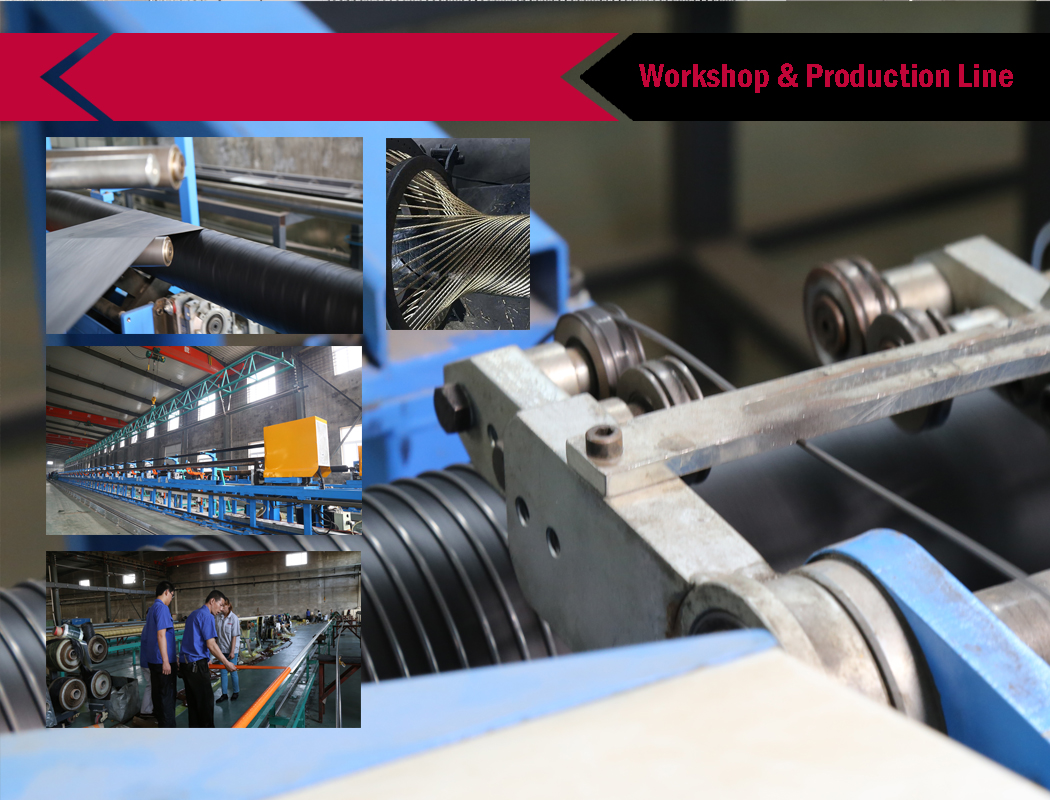
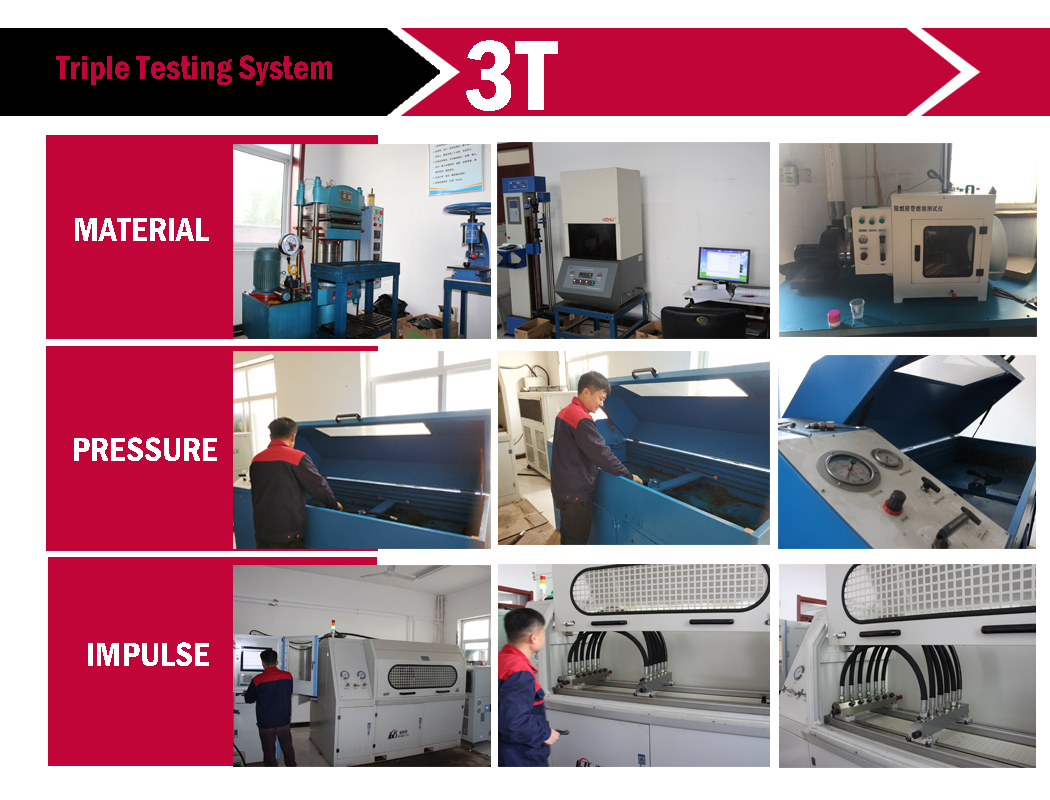
Disponiamo di un'ampia gamma di tubi flessibili industriali sul mercato, in grado di soddisfare le diverse esigenze di pressione delle vostre applicazioni.
Tubo flessibile per aria e acqua
Tubo flessibile per olio combustibile
Tubo flessibile in cemento
Tubo chimico
Tubo di aspirazione e scarico
Tubo benzina
Tubo flessibile per saldatura
Tubo flessibile per sabbiatura
Tubo flessibile per autocisterna
Tubo flessibile di mandata del materiale
Tubo flessibile per uso alimentare
Tubo flessibile del vapore
Tubo flessibile in silicone
Tubo freno
Tubo flessibile A/C
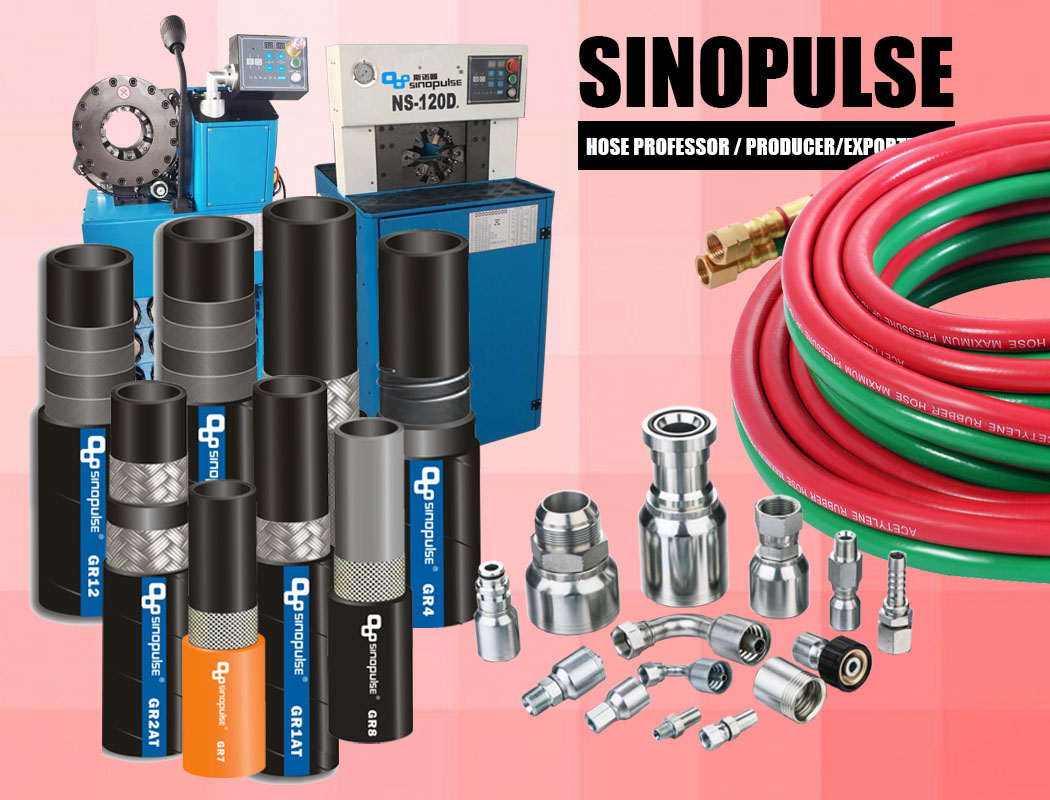
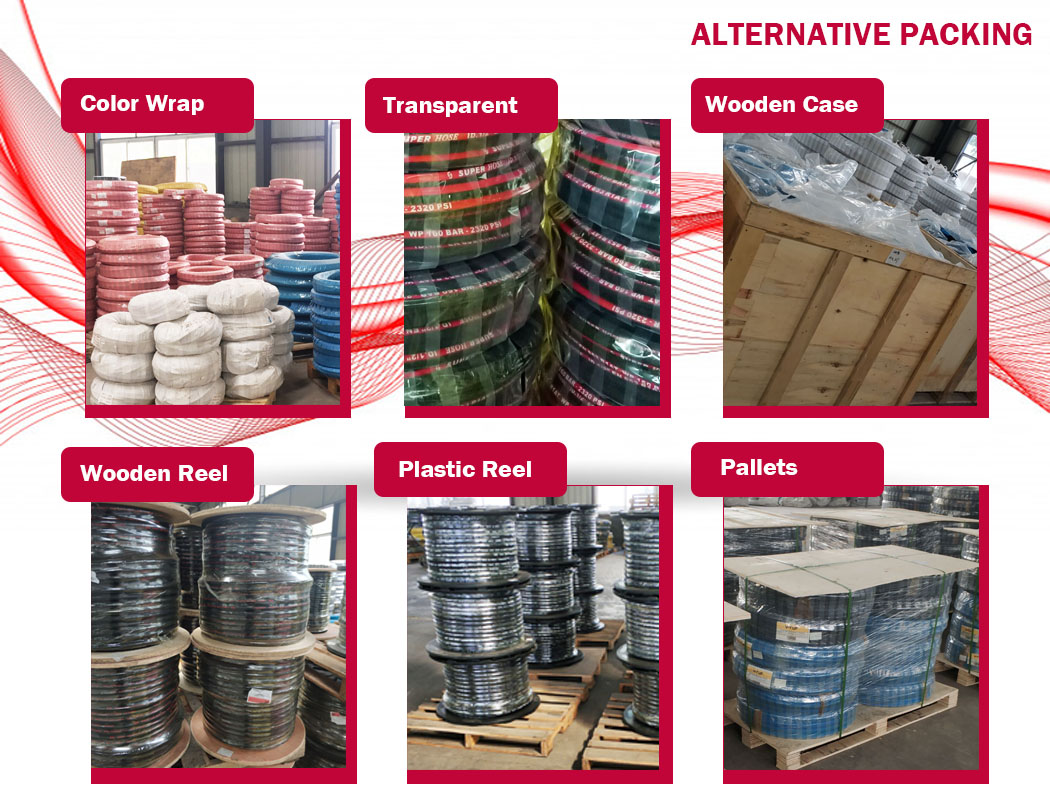
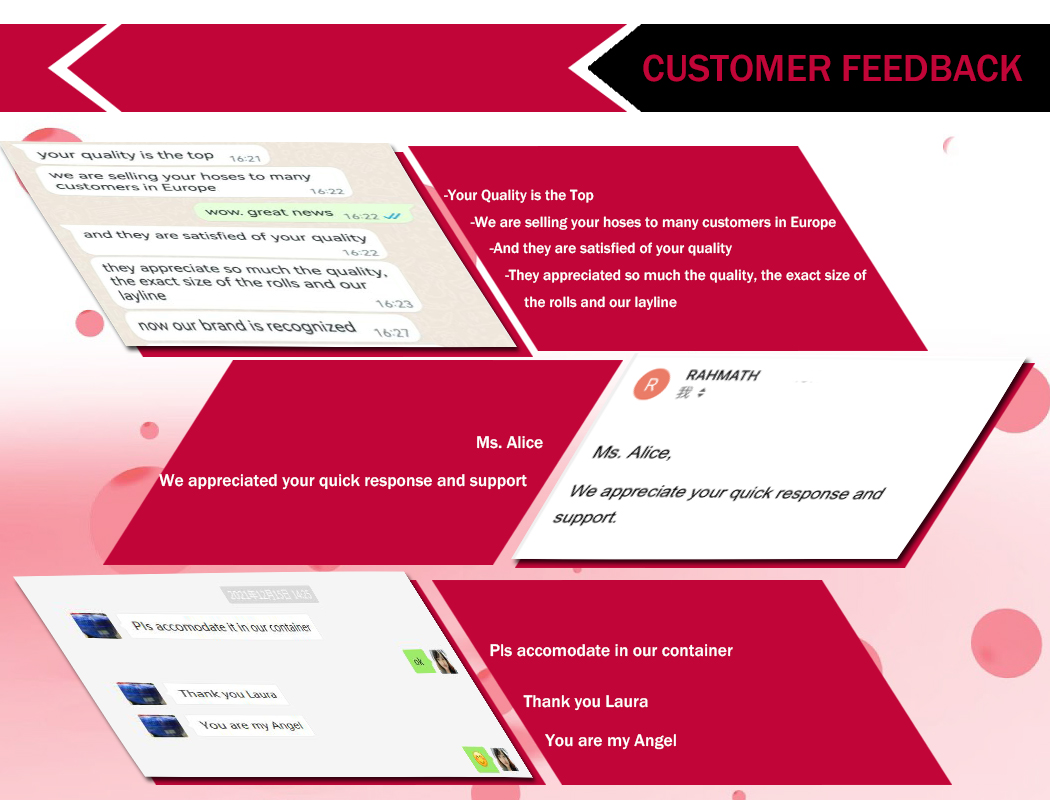
Decoding the Core Materials Hygienic Design Principles of Food Grade Hoses
SINOPULSE engineers food-grade hoses with a meticulous focus on material purity and hygienic design, ensuring safe and compliant transfer of food and beverage products. The selection of core materials and the architecture of these hoses play a pivotal role in meeting strict industry standards while delivering reliable performance for food transfer hose applications.
1. FDA-Compliant Elastomeric Materials: The Foundation of Purity
SINOPULSE food grade hoses are built with inner tubes crafted from premium elastomers like ethylene-propylene-diene-monomer (EPDM) or nitrile-butadiene rubber (NBR), both rigorously certified to FDA 21 CFR 177.2600 for direct food contact. EPDM, with its non-polar molecular structure, excels in resisting aqueous solutions, making it ideal for transferring water-based foods like juices, dairy, and sauces. NBR, fortified with food-safe additives, offers superior resistance to oils and fats, critical for conveying edible oils, margarine, or bakery products. These materials are free from phthalates, heavy metals, and other contaminants, ensuring zero migration of harmful substances into the food stream—an essential feature for multipurpose hose 20 bar applications requiring both versatility and safety.
2. Smooth-Bore Design for Hygienic Flow
The inner surface of SINOPULSE food transfer hoses is engineered to a surface roughness of ≤0.8μm (Ra), minimizing product residue buildup and facilitating easy cleaning. This smooth bore reduces the risk of bacterial growth or cross-contamination, a critical advantage in sensitive processes like infant formula production or pharmaceutical-grade syrup transfer. Unlike conventional hoses with textured interiors, our seamless design eliminates crevices where particulates could lodge, supporting compliance with stringent cleaning protocols such as Clean-in-Place (CIP) and Sterilize-in-Place (SIP).
3. Reinforcement Layers for Pressure Stability
To meet the demands of high-pressure systems—including 20 bar hose and 20 bar air hose applications—SINOPULSE integrates spiral-wound stainless steel wire or high-tensile polyester braids into the hose structure. These reinforcement layers distribute internal pressure evenly, enabling working pressures up to 20 bar (300 PSI) while maintaining flexibility for easy installation. The stainless steel option, in particular, adds corrosion resistance, making it suitable for harsh cleaning agents used in food processing facilities.
4. Outer Cover Protection Without Compromise
The outer layer of SINOPULSE food grade hoses is constructed from abrasion-resistant, non-toxic synthetic rubber or thermoplastic elastomers (TPE), designed to withstand physical abuse in industrial environments without compromising hygiene. UV-resistant formulations are available for outdoor use, preventing material degradation from sunlight exposure, while anti-static additives in select models eliminate electrostatic hazards when handling flammable food products like alcohol or spirits.
Certifications Beyond Compliance
In addition to FDA approval, SINOPULSE hoses undergo rigorous testing to meet NSF 51 (for food contact materials) and USP Class VI (for pharmaceutical applications), ensuring suitability for even the most sensitive food and beverage transfer tasks. Each hose is traceable through its material supply chain, guaranteeing no recycled materials are used—a critical factor for brands prioritizing product integrity.
Whether transferring delicate dairy products, viscous sauces, or high-alcohol beverages, SINOPULSE food grade hoses combine advanced material science with hygienic engineering to deliver safe, efficient, and compliant solutions. As a trusted industrial hose manufacturer, we understand that in food processing, purity is not just a feature—it’s a necessity.
Cleanliness Verification and Maintenance Protocols for Food Grade Hoses
As a reputable industrial hose manufacturer, SINOPULSE recognizes that the safety and integrity of food products rely not only on the quality of food-grade hoses but also on proper cleaning and maintenance. Our food transfer hoses are engineered to meet strict hygiene standards, and following the right verification and maintenance practices ensures their long-term performance and compliance with food safety regulations.
1. Cleaning Verification: Ensuring Purity with Rigorous Testing
SINOPULSE food grade hoses are designed to support comprehensive cleaning verification processes. For hoses used in high-risk applications, such as dairy or infant food production, we recommend conducting residue tests after each cleaning cycle. A simple visual inspection for any visible residue is the first step. For more precise verification, swab tests can be performed on the inner surface of the hose. These swabs are then analyzed for microbial presence, ensuring that the hose is free from bacteria, yeasts, or molds.
In facilities using Clean-in-Place (CIP) systems, SINOPULSE 20 bar hose and multipurpose hose 20 bar models are designed to withstand the high-pressure cleaning solutions typically used. The smooth inner bore (≤0.8μm Ra) of our hoses facilitates efficient cleaning, reducing the risk of residue buildup. To verify the effectiveness of CIP, water conductivity tests can be conducted post-cleaning. A significant drop in conductivity indicates the removal of contaminants, confirming the hose’s cleanliness.
2. Maintenance Protocols: Prolonging Hose Lifespan
Regular maintenance is key to extending the lifespan of SINOPULSE food-grade hoses. Visual inspections should be carried out frequently to check for signs of wear, such as cracks, bulges, or abrasions on the outer cover. For hoses used under high-pressure conditions, like 20 bar air hose or 20 bar hose applications, pressure testing should be performed annually. This ensures that the hose can still handle the required working pressure of 20 bar (300 PSI) without compromising safety.
When not in use, food transfer hoses should be stored in a clean, dry environment away from direct sunlight. SINOPULSE hoses with UV-resistant outer covers are suitable for outdoor storage, but indoor storage is still recommended for maximum protection. Additionally, hoses should be coiled loosely to prevent kinking, which can damage the internal reinforcement layers and affect pressure-handling capabilities.
3. Record-Keeping for Traceability
SINOPULSE emphasizes the importance of maintaining detailed records of all cleaning and maintenance activities. This includes the date of cleaning, the type of cleaning agent used, and the results of any verification tests. For an industrial hose manufacturer, compliance and customer assurance, these records provide traceability, demonstrating that the hoses are being properly maintained and are safe for food transfer.
By following SINOPULSE’s cleanliness verification and maintenance protocols, food processing facilities can ensure the continued safety and reliability of their food-grade hoses, safeguarding both their products and their brand reputation.









